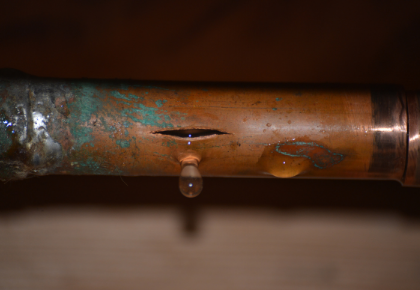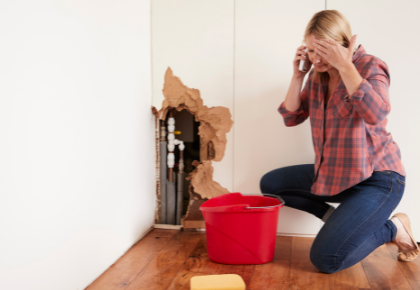Winters in Alberta can be long, cold, and unpredictable. The winter weather may bring a lot of outdoor fun, but it can also create a lot of problems indoors that can be expensive to fix. When living in a large multi-family building, one of the biggest concerns is the potential for frozen pipes in frigid temperatures.
If water lines freeze, they burst causing significant property damage
 If your building is heated by water that circulates through baseboard pipes, it is critical that these water lines do not freeze during one of the many cold snaps that Alberta faces throughout the winter.
If your building is heated by water that circulates through baseboard pipes, it is critical that these water lines do not freeze during one of the many cold snaps that Alberta faces throughout the winter.
The thermostat controls the electric zone valves on the pipes to lower or raise the room temperature. If ice forms anywhere in the pipe, the water line pressure increases and can cause the valve to fail and release the water into the room.
It’s important to understand that the system has an unlimited water supply; meaning a tremendous amount of damage can result before the water is turned off. Unfortunately, it is often not just a single unit that is impacted. Suites adjacent and below are affected as the water can travel down several floors and leave a long trail of destruction.
The cost of frozen pipes affects all owners
 Damage from a burst pipe can cost thousands of dollars to repair. While it is usually insured, there are financial consequences to all owners. Most often, the deductible is paid by the condominium corporation as the water lines are shared between units and run throughout the common areas. However, in some cases, it may be determined that a resident is responsible for the frozen pipe, and the payment of the deductible would then fall to the unit owner. Not to mention, any damage caused to property owned by the resident, such as furniture or clothing, is their own responsibility.
Damage from a burst pipe can cost thousands of dollars to repair. While it is usually insured, there are financial consequences to all owners. Most often, the deductible is paid by the condominium corporation as the water lines are shared between units and run throughout the common areas. However, in some cases, it may be determined that a resident is responsible for the frozen pipe, and the payment of the deductible would then fall to the unit owner. Not to mention, any damage caused to property owned by the resident, such as furniture or clothing, is their own responsibility.
When such a claim is placed, deductibles can increase up to $50,000. When too many claims are placed, it can become difficult for the condo corporation to renew its insurance, creating additional problems.
Do your part to prevent frozen pipes
While letting some fresh air into your unit can be desirable even in the cold winter months, this is not advisable in below-freezing temperatures. A window or patio door left open in the cold weather is the usual cause of a frozen water line. In addition to keeping windows and patio doors closed, ensure that any window treatments or furniture are not covering or blocking the baseboard heating. This can channel cold air down the wall and freeze the water lines.
Stay informed by keeping an eye on your community’s communication channels, as the management office will often send a quick note when extreme cold is on the way as a reminder to do your part in preventing frozen pipes. It is also beneficial to learn how to shut the water off in case of an emergency. Shut-off valves are located at the pipe’s entrance to and exit from your suite.
What to do when the temperature is at or below zero
If the temperature is rising in your unit as you’re cooking a big meal, it might be second nature to crack open the window to bring the temperature down quickly. However, in the colder winter months, you should never leave a window or patio door open for any length of time. A space of just one inch can cause a pipe to freeze within minutes. Cold air is heavier than warm air. Even if the window is five feet above the floor, the cold air will travel to the floor and freeze the water line.
When in one of the common areas, do not prop open outside doors for easy access; pipes in the stairwells or foyer may freeze. While working out in the gym, it may feel too hot and propping open the door may seem like a quick and easy solution to cool down, it can result in more issues. Talk to the condominium manager about lowering the temperature in the gym if the room is uncomfortably warm.
The thermostat should never be set below 17 degrees during the cold weather, even if you are going away on vacation and the unit will be vacant for an extended period of time. The zone valve needs to cycle on and off regularly to allow water to flow through the pipe to prevent ice. It goes without saying that you should never turn the thermostat completely off.
Review your condo corporation’s governing documents and your insurance coverage
 The governing documents of your condo corporation should outline who is responsible for the different types of repairs that unit owners may be faced with. That includes repairs from damages caused by frozen pipes. As of January 1, 2020, condominium corporations could begin charging back the insurance deductible to unit owners due to the escalating cost of those deductibles. Your condo corporation’s governing documents should have been revised to reflect those changes. If they haven’t, you should speak with your condominium management company.
The governing documents of your condo corporation should outline who is responsible for the different types of repairs that unit owners may be faced with. That includes repairs from damages caused by frozen pipes. As of January 1, 2020, condominium corporations could begin charging back the insurance deductible to unit owners due to the escalating cost of those deductibles. Your condo corporation’s governing documents should have been revised to reflect those changes. If they haven’t, you should speak with your condominium management company.
To better understand how you are covered as an owner or tenant, review your insurance coverage through a consultation with your broker. Of course, you should have a policy that covers any damage to your personal possessions like furniture due to water damage.
Additionally, your unit insurance policy should include coverage for alternate accommodation in the occurrence you can’t live in your unit while repairs are taking place. It should also include coverage in the event you are assessed the deductible portion of a claim. If that’s not included, it’s strongly worth considering revising your policy to include it to ensure you don’t get stuck paying a large deductible out of your own pocket.
Avoiding the damage caused by frozen pipes takes the cooperation of the entire condo corporation, but it can be done if all residents take preventative measures. For more essential tips on how to stay winter-safe, don’t hesitate to get in touch with FirstService Residential Alberta.